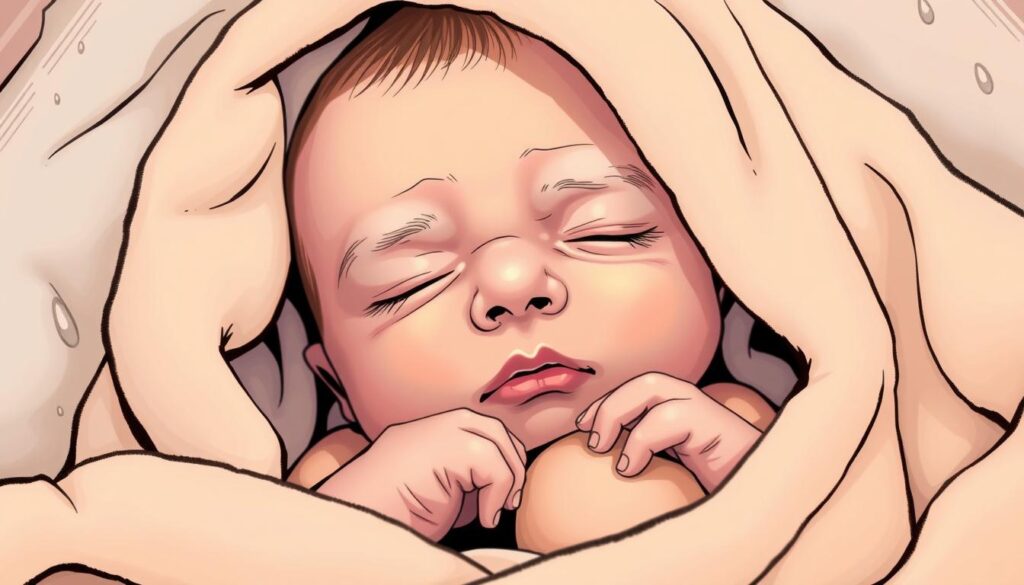How to Keep Baby Warm Without Overheating
As the temperatures drop, ensuring your newborn’s comfort and safety becomes a top priority. Did you know that almost all of the 500 fires caused per year by electric blankets are due to blankets that are over 10 years old? This alarming statistic underscores the importance of understanding how to properly warm your baby during the winter months without putting them at risk of overheating or fire hazards.
This comprehensive guide will provide you with the essential information you need to manage baby warmth in winter, offering winter newborn care tips and strategies to prevent hypothermia in babies. From understanding your infant’s unique temperature regulation needs to implementing safe heating practices and proper clothing layering techniques, you’ll learn how to create a cozy, comfortable, and secure environment for your little one.
Key Takeaways
- Understand the normal body temperature range for infants and why they require special temperature care
- Establish essential room temperature guidelines for a safe and comfortable sleep environment
- Discover effective strategies for managing baby warmth during the winter, both indoors and outdoors
- Learn how to properly layer baby clothing and use sleep sacks to prevent overheating or hypothermia
- Recognize the signs of overheating and cold stress in babies, and know when to seek medical attention
Understanding Baby Temperature Regulation
Monitoring your baby’s skin temperature is crucial for detecting signs of being too cold or overheated. Infants typically have a normal body temperature range of 97.5°F to 100.4°F (36.4°C to 38°C). However, babies require special temperature care due to their underdeveloped thermoregulation system.
Normal Body Temperature Range for Infants
A baby’s normal body temperature can vary slightly from day to day and even throughout the day. It’s important to understand the typical temperature range to ensure your little one is staying comfortable and healthy.
Why Babies Need Special Temperature Care
Babies’ bodies are still developing their ability to regulate temperature. They have a limited capacity to sweat, which is the primary way adults cool down. This makes infants more vulnerable to temperature fluctuations and the risks of overheating or becoming too cold.
Impact of Age on Temperature Sensitivity
Newborns are particularly sensitive to temperature changes due to their immature temperature regulation system. As infants grow older, their ability to maintain a stable body temperature improves, but they still require close monitoring and careful temperature management.
Essential Room Temperature Guidelines
Maintaining the right room temperature is crucial for keeping your infant comfortable and safe. The ideal room temperature for infants should be between 68°F to 72°F (20°C to 22°C). This temperature range helps ensure your baby’s body can regulate their temperature effectively without the risk of overheating or feeling too cold.
To achieve and maintain this optimal temperature, utilize efficient heating systems in your home. Consider using a space heater with safety features like tip-over protection and overheat prevention to provide localized warming in your baby’s room. Proper ventilation is also important to prevent stuffiness and maintain air quality.
| Heating System | Features | Average Price |
|---|---|---|
| BedSure Electric Blanket | 20 colors, 5 sizes, 6 heat settings | $30+ |
| Tefici Flannel Heated Blanket | 3 heat settings, auto shut-off | $35+ |
| Homemate Heated Blanket | 10 heat levels, 12.5-foot cord | $28+ |
By maintaining the right room temperature for infants, you can help ensure your baby’s comfort and well-being, especially during the colder winter months when managing baby warmth is of utmost importance.
Managing Baby Warmth in Winter
As the temperatures drop and winter approaches, keeping your newborn warm becomes a top priority. Maintaining the right balance between preventing hypothermia and avoiding overheating is crucial for your baby’s comfort and well-being. Here are some essential tips to manage your little one’s warmth during the colder months.
Indoor Temperature Control Tips
Use a thermostat to maintain a consistent indoor temperature, typically between 68-72°F (20-22°C). This helps create a comfortable, cozy environment for your baby. Avoid sudden temperature fluctuations, as they can disrupt your newborn’s temperature regulation.
Outdoor Protection Strategies
When venturing outdoors, dress your baby in layers to provide ample insulation. This may include a onesie, sweater, and coat or snowsuit, depending on the weather conditions. Remember to use a weather-appropriate stroller cover to shield your little one from the elements.
Monitoring Baby’s Comfort Level
To ensure your baby’s warmth is just right, regularly check their neck and back for signs of sweat or coolness. If their skin feels cool to the touch, add an extra layer. Conversely, if they appear flushed or sweaty, remove a layer to prevent overheating.
For small, targeted areas, consider using a portable heater to provide additional warmth while conserving energy. By implementing these winter newborn care tips and preventing hypothermia in babies, you can keep your little one comfortable and safe throughout the colder months.

Safe Layering Techniques for Baby Clothing
Dressing layers for babies is crucial in managing their warmth during the winter months. The key is to use the “plus one” rule – dress your little one in one more layer than an adult would wear in the same conditions. Start with a thin, breathable base layer to wick away moisture, then add insulating middle layers to trap body heat, and finish with a weather-resistant outer layer for outdoor trips.
Avoid overly bulky clothing that can restrict your baby’s movement and make it difficult to gauge their temperature. Dressing layers for babies should allow for easy movement and provide just the right amount of warmth without overheating.
- Base layer: Choose a lightweight, moisture-wicking material like cotton or bamboo.
- Middle layers: Opt for soft, breathable fabrics like fleece or wool to insulate.
- Outer layer: Select a wind- and water-resistant jacket or parka to shield against the elements.
Remember, managing baby warmth in winter is a delicate balance. Monitor your baby’s comfort level and adjust the layering as needed to ensure they stay cozy and content.
Choosing the Right Sleep Environment
Creating a safe and comfortable sleep environment is crucial for your baby’s well-being. When it comes to keeping your little one warm, the choice between baby sleep sacks and traditional baby blankets can make a significant difference.
Sleep Sack vs. Traditional Blankets
Sleep sacks, also known as wearable blankets, are a safer alternative to traditional loose blankets. They provide the necessary warmth without the risk of your baby’s face getting covered, which can be a serious safety hazard. Sleep sacks are designed to keep your baby’s arms and legs free, allowing for easy movement and reducing the likelihood of suffocation.
Crib Safety Guidelines
In addition to choosing the right sleepwear, it’s essential to follow crib safety guidelines. Keep the sleeping area clear of any loose bedding, toys, or other objects that could potentially obstruct your baby’s breathing. Maintain a clutter-free, well-ventilated crib environment to ensure your baby’s safety and comfort throughout the night.
Night Temperature Monitoring
Monitoring the room temperature during the night is crucial for maintaining your baby’s comfort and preventing overheating or chilling. Use a room thermometer to keep the temperature consistent, typically between 68°F and 72°F (20°C and 22°C). Regularly check on your baby’s comfort level and adjust the temperature or clothing layers as needed.
By choosing the right sleep environment, following safe practices, and monitoring the temperature, you can help ensure your baby stays warm and cozy throughout the night, promoting restful and healthy sleep.
Signs of Overheating and Cold Stress
Monitoring your baby’s temperature is crucial to ensure their comfort and well-being. Understanding the signs of overheating and cold stress can help you take the necessary steps to keep your little one at the optimal temperature.
Signs of Overheating:
- Sweating
- Flushed cheeks
- Rapid breathing
- Hot skin
Signs of Cold Stress:
- Cool extremities
- Pale skin
- Lethargy
Regularly check your baby’s neck, back, and chest to assess their temperature. Keep in mind that crying can raise a baby’s temperature, so allow time for them to calm down before making any temperature adjustments.
| Signs of Being Too Cold | Signs of Being Too Hot |
|---|---|
| Cool extremities, pale skin, lethargy | Sweating, flushed cheeks, rapid breathing, hot skin |
By being attentive to these signs, you can ensure your baby’s comfort and take prompt action to maintain the ideal temperature for their well-being.

Special Considerations for Preterm Babies
Preterm babies face unique challenges when it comes to regulating their body temperature. Their smaller size and underdeveloped temperature control mechanisms make them more susceptible to both overheating and hypothermia. Preterm baby warmth is a critical concern that requires additional care and monitoring.
Temperature Regulation Challenges
Premature infants have less body fat, which acts as insulation to retain heat. As a result, they are more prone to rapid heat loss through conduction, convection, radiation, and evaporation. This makes them vulnerable to baby skin temperature monitoring issues like hypothermia, especially in colder environments.
Additional Warming Methods
- In the hospital, preterm babies may be placed in incubators or under radiant warmers to maintain a stable and comfortable temperature.
- At home, skin-to-skin contact, also known as “kangaroo care,” can help regulate the baby’s temperature by sharing the parent’s body heat.
Medical Monitoring Requirements
Preterm infants often require continuous medical supervision, including frequent temperature checks and the use of specialized equipment to monitor their vital signs. This close monitoring helps ensure their temperature remains within the normal range and that any signs of distress or temperature-related issues are promptly addressed.
| Statistic | Value |
|---|---|
| Normal body temperature | Around 37°C (98.6°F) |
| Hypothermia threshold | Below 35°C (95°F) |
Using Temperature Monitoring Devices
As parents, keeping our little ones comfortable and safe is a top priority. When it comes to managing baby’s temperature, having the right monitoring devices can make all the difference. From quick and non-invasive infrared thermometers to room temperature sensors, these tools can help us stay on top of our baby’s needs and maintain a cozy, consistent environment.
Infrared thermometers provide a simple, fuss-free way to check baby’s skin temperature without disturbing their rest. These handheld devices measure the heat radiating from the forehead or other exposed areas, giving us an accurate reading in just seconds. For continuous monitoring, some baby monitors even come equipped with built-in temperature sensors, alerting us if the room climate shifts outside of the ideal range.
For preterm or at-risk infants, wearable temperature tracking devices can offer an extra layer of protection. These discreet, comfortable patches or bands monitor skin temperature around the clock, providing valuable insights to caregivers. By staying on top of any fluctuations, we can ensure our little ones are never too hot or too cold.
| Device | Key Features | Benefits |
|---|---|---|
| Infrared Thermometer |
|
|
| Room Thermometer |
|
|
| Wearable Temperature Monitor |
|
|
With the right temperature monitoring tools, we can keep a close eye on our baby’s warmth and comfort, ensuring they thrive in a safe, well-regulated environment. By staying vigilant and responding promptly to any changes, we can provide the care and support our little ones need to grow and develop.
Conclusion
Maintaining the right temperature for your baby during the winter months is crucial for their health and comfort. By understanding the principles of infant temperature regulation, implementing safe warming strategies, and utilizing appropriate monitoring techniques, parents can ensure their little one stays warm without the risk of overheating.
Adhering to room temperature guidelines, using effective layering methods for clothing, and creating a cozy yet secure sleep environment are all essential steps in managing baby warmth in winter. Additionally, being aware of the signs of both overheating and cold stress can help parents respond quickly and effectively to their baby’s needs.
Remember, every baby is unique, and it’s always best to consult with healthcare professionals, especially for preterm or medically vulnerable infants. With the right winter newborn care tips and a vigilant approach, parents can navigate the colder months with confidence, ensuring their little one stays snug, safe, and thriving.







